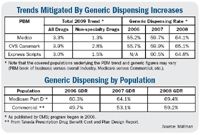Generic opportunities slow
Patent expirations are slowing and other tools are needed to manage costs

An analysis by the Milliman actuarial and consulting firm found that a move toward generic dispensing has sharply slowed national drug spending, to less than a 4% increase in 2009. For the three largest pharmacy benefit managers-Medco, CVS Caremark, and Express Scripts-the generic dispensing rate from 2006 to 2008 rose from about 55% to 65%.
The analysis, by actuary Troy Filipek in Milwaukee, predicts the trend will weaken after 2011 because fewer major brand-name drugs will go off-patent, reducing the potential for savings from generic substitution.
"Prescription drug [cost] trends have been very low compared with the last 15 years," Filipek tells MANAGED HEALTHCARE EXECUTIVE. "But you're going to hit a saturation point where you can't mitigate cost growth. There won't be that many broad-use branded drugs left on patent."
In line with his analysis, a study in the Dec. 16, 2009, issue of Health Affairs found a decline in spending for drugs prescribed by primary care physicians, including cholesterol, gastrointestinal, respiratory, antidepressant, and antidiabetic drugs. Employers and pharmacy benefit managers, the study says, have deployed aggressive formularies and benefit designs to successfully prod consumers toward generics and cheaper brand-name products.
Journal authors reported a significant increase in spending for biologics and vaccines prescribed by specialists, particularly cancer drugs. While real spending growth for primary care-driven drugs fell to 3.7% in 2007, spending for specialist-driven drugs rose 8.9%.
The article indicates payers will not be able to use generic or brand-drug competition as a tool to moderate spending on unique, life-saving products such as cancer drugs.
CREATIVE BENEFIT DESIGN
Filipek agrees in the Milliman report, saying escalating trends in the specialty market have become a bigger issue. New specialty releases and slowing generic dispensing rates no longer mask the cost growth trend. Health plans will have to get more innovative about how they manage pharmaceutical spending.
If health plans are required to meet specific medical loss ratios, that could limit plans' ability to set higher cost-sharing for branded drugs and to steer members toward less costly products. In addition, Filipek is concerned that allowing Medicare to negotiate prices with drugmakers could boost prices for other payers.
Still, the journal authors say the modest drug spending growth of recent years suggests a significantly more positive scenario for total medical spending than many observers fear.
Given the patent expirations of drugs that account for a large portion of pharmaceutical spending, they write, "further efforts to limit the uptake of new therapies" through formulary and benefit design might not be necessary.
David Calabrese of OptumRx Talks New Role, Market Insulin Prices and Other Topics 'On His Mind'
April 13th 2023In this month’s episode of the "What's On Your Mind podcast," Peter Wehrwein, managing editor of MHE connects with the now Chief Clinical Officer of OptumRx Integrated Pharmacies, David Calabrese. In this conversation, David touches on his transition in January as OptumRx’s former chief pharmacy officer and market president of health plans and PBMs to his new role as Chief Clinical Officer where he now focuses more on things such as specialty pharmacy to home delivery — with an overall goal of creating whole-patient care. Throughout the conversation, Calabrese also touched on the market’s hot topic of insulin prices and behavioral health services within the OptumRx community, among other topics.
Listen
Upended: Can PBM Transparency Succeed?
March 6th 2024Simmering tensions in the pharmacy benefit management (PBM) industry have turned into fault lines. The PBMs challenging the "big three" have formed a trade association. Purchaser coalitions want change. The head of the industry's trade group says inherent marketplace friction has spilled over into political friction.
Read More
Briana Contreras, editor of Managed Healthcare Executive, spoke with Nancy Lurker, CEO and president of EyePoint Pharmaceuticals. Nancy shared a bit about EyePoint and how the organization’s innovative therapies are addressing patient needs through eye care, and most importantly, she addressed C-Suite positions like the CEO role. Nancy shared advice for those seeking to reach the CEO level, especially toward women in healthcare and other roles, and what it takes to run a biopharma company.
Listen
The deliberate disconnection of Change Healthcare to ring fence a cyberattack entered its seventh day today. Prescribers are finding ways to get pharmacy claims processed, and UnitedHealth Group says disruption to the dispensing of prescriptions has been minimal. But independent pharmacies want more information and protection from financial consequences from pharmacy benefit managers.
Read More